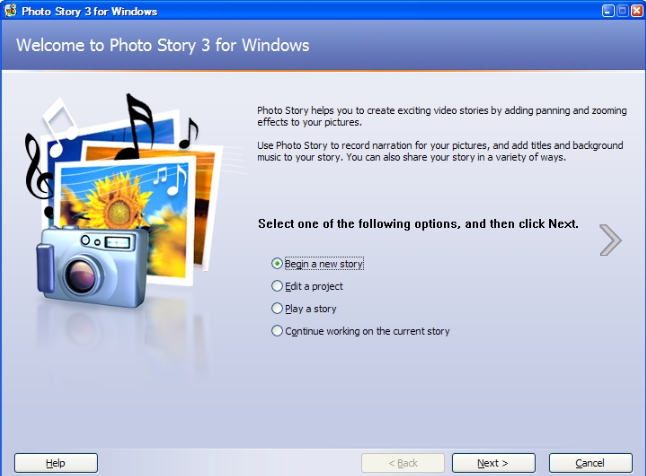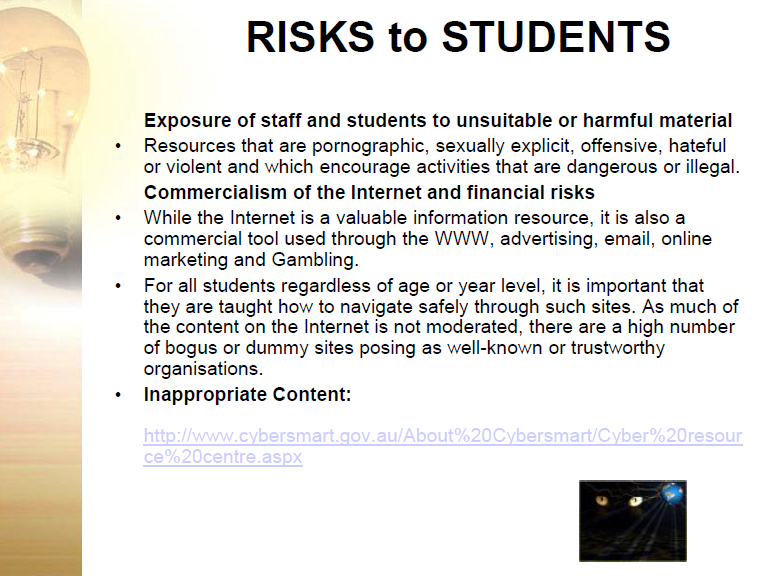Lecture
Having a plan B for any technology based learning is extremely important for any teacher. The snapshot of the future that Greg shared demonstrated an insight into what classrooms may look like (if they are well funded). If the technology isn't working or access is restricted due to poor wifi coverage or computer unavailability, teachers need to have a counter plan. Opportunities explored in the clip 'Bridging Our Future', such as connections to experts in the field, may be explored in classrooms through arctic explorers, astronauts (NASA has an amazing range of educational resources, including live broadcasts from space), sailors (such as Jessie Martin) and CSIRO. The simplicity of connection via programs such as Skype or FaceTime is no longer accessible to the few. Being able to contact family whilst they are overseas via these means has made distance irrelevant for my children.
Involving students in ethical digital citizenship conversations may occur as part of regular classes. The difficulty I see is engaging parents in these conversations. The ThinkUKnow website is a useful resource for guiding teachers, parents and students in ways to navigate the technology of today. It is a resource which I encourage my preservice teachers to subscribe to. Having students and parents agreeing to
Acceptable Use Agreements (AUA) is very important so all users understand the expectations of technology use (at LaTrobe, the AIM is supposed to cover this for our adult users). I believe that my 14 year old needs to demonstrate that she can negotiate face-to-face with her peers successfully before being exposed to having to navigate social media. Being active in the classroom and being able to view all computer screens is extremely important to me. I make a point of constantly rotating through the room to assist with technical concerns and also view students' on task behaviours.
The risks (hateful, racist, pornographic, commercial, financial or spam) associated with Internet use is
essential learning for all users. The reading 'Protecting yourself online' discusses safety and security risks and how users can possibly reduce these. The 8 simple tips for online safety have practical examples that should be integrated into all learning on cybersafety. The additional resources listed in this document are great. However, there are so many positives that should not be overshadowed by this essential learning. It is important that students understand cyberbullying laws. Cyberbullying can occur 24/7. The argument of whether it is still the teacher' role after school to ensure duty of care of their students is constantly discussed.
 Educating students at a young age about student identity protection, phishing emails and spam are so very important. My 6 year old son learnt this lesson when he was so excited whilst playing a game via the Disney channel and a pop up window said that he had won a trip to Disneyland. We discussed the ideas of commercialism, spam and identify security and as a result, both of my children (now 14 & 11) know how much information is too much information.
Educating students at a young age about student identity protection, phishing emails and spam are so very important. My 6 year old son learnt this lesson when he was so excited whilst playing a game via the Disney channel and a pop up window said that he had won a trip to Disneyland. We discussed the ideas of commercialism, spam and identify security and as a result, both of my children (now 14 & 11) know how much information is too much information. | These flashy popups may appear harmless |
The legalities of sexting is an issue often avoided in discussions but must be addressed with all learners. The legal implications of the distribution of a sexy photograph taken by oneself is frightening and teenage girls in particular need to know that this behaviour is illegal. I feel for the person receiving this image (often a boy) who may then be charged with possessing pornographic material. The lifelong impact of possessing and distributing these materials I believe is unknown to teenagers (most often those involved in this practice) and must be incorporated into cybersafety education of high school students. The Sex & Tech reading is a valuable resource for both students and teachers with clear data on the occurrences of sexting related issues. The ThinkUKnow website in conjunction with the Australian Federal Police also have some great resources on this issue.
This lecture also provided some great links to useful websites. I will be adding these to my Delicious account so that all of my undergraduate students have access to them.
Makebeliefscomix
 With no sign up required I can see primary school students really enjoying creating a comic strip in Makebeliefscomix. I can see students utilising this resources as a fun, creative writing tool, but for teachers, it could be utilised as a summary of prior leaning on a topic, a way to express character development or a method in succinct story writing.
With no sign up required I can see primary school students really enjoying creating a comic strip in Makebeliefscomix. I can see students utilising this resources as a fun, creative writing tool, but for teachers, it could be utilised as a summary of prior leaning on a topic, a way to express character development or a method in succinct story writing. Wordle
 One of my favourite simple visual tools is Wordle. To create a word web that uses colour and size to emphasise key words has many applications in the classroom as well as higher education. As a brainstorming tool Wordle can be used to create quick digital word wall displays. I have used it as a summary tool of my lectures at the end of semester, pasting my lecture notes into the tool and creating a visual display of key points for students. I have also used the tool for finding themes within student papers and reflections as well as academic journal articles. There are so many applications of this very simple online tool.
One of my favourite simple visual tools is Wordle. To create a word web that uses colour and size to emphasise key words has many applications in the classroom as well as higher education. As a brainstorming tool Wordle can be used to create quick digital word wall displays. I have used it as a summary tool of my lectures at the end of semester, pasting my lecture notes into the tool and creating a visual display of key points for students. I have also used the tool for finding themes within student papers and reflections as well as academic journal articles. There are so many applications of this very simple online tool. Photostory 3
 Another simple free tool for students to create a multimedia response to an assessment task (I have first year preservice teachers create a digital story of their 'virtual literacy backpack') or a personal pictorial display that incorporates photos, titles, audio and effects. This is a very simple program that I have had VCAL students in a Special Education setting use to create their own digital portfolio of their learning.
Another simple free tool for students to create a multimedia response to an assessment task (I have first year preservice teachers create a digital story of their 'virtual literacy backpack') or a personal pictorial display that incorporates photos, titles, audio and effects. This is a very simple program that I have had VCAL students in a Special Education setting use to create their own digital portfolio of their learning. Go Animate
 I can see Go Animate having a place in the subject Interactive Technologies (4th year elective in Bach Ed) where students are able to tell a story to show conceptual learning. There are so many versions of this program that I have had experience with, such as Stop motion, Lego Movie Maker (iPad app) or iPhoto (my favourite desktop program for photo slideshows). Other students mentioned programs such as LapseIt and Domo Animate which I would like to explore (in my spare time :-)
I can see Go Animate having a place in the subject Interactive Technologies (4th year elective in Bach Ed) where students are able to tell a story to show conceptual learning. There are so many versions of this program that I have had experience with, such as Stop motion, Lego Movie Maker (iPad app) or iPhoto (my favourite desktop program for photo slideshows). Other students mentioned programs such as LapseIt and Domo Animate which I would like to explore (in my spare time :-)Mobile Technologies
The power of mobile devices in today's classroom I believe is still an under explored area. Whilst I have been involved in setting up computers in classrooms, the netbook programs in schools, iPads for learning and using such hardware such as flipcams, iPods, digital cameras and smart phones, the integration of these devices is yet to be realised.
Scootle
Wow! I love this collection of educational resources, but most importantly, I love the unified
approach to building a quality resource that is so closely linked to the Australian Curriculum. Victoria's FUSE was not as easy to navigate and did not have clear links to curriculum. Scootle has managed to streamline all resources and it's search engine is intuitive. This is a resource that I personally use in my teaching, but one I also strongly encourage my undergraduate students to access and use during their Practicum, their assessment requirements as well as in their own classrooms.
Roller Mâché
I was so pleased to reintroduced to Roller Mâché. I haven't accessed this resource for some time, but love the videos that explain the processes of animation as well as the practical examples and useable templates (I've used the storyboard during my Interactive Technologies subject and love the simplicity of this document). What a great way to explain animation to students.
Dvolver
Whilst there are some good features to Dvolver, the potentially negative content makes this program inappropriate for my classroom. This program relies on students using the available resource in an appropriate way. I feel other applications may involve students in these same processes without the associated risks.
Sketch Swap
 |
| The image I received - it is rather abstract. |
 |
| My attempt at sketching |
Design Briefs

 |
| Strands of Design and Technology in the Australian Curriculum |

Other resources
There have been so many resources shared today including Smilebox, Catchment Detox, Skwirk and Yenka to name a few. The documents accessible via the LMS are too valuable to lose, so I have attached them here for my future retrieval.
Animation websites
Extra Resources
Bridging Our Future




No comments:
Post a Comment